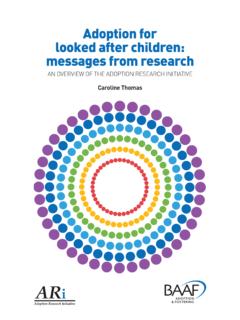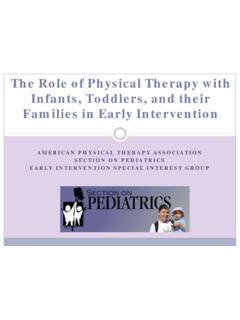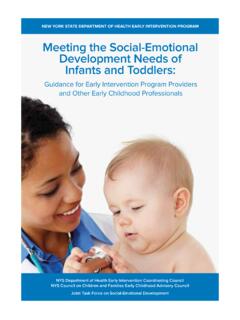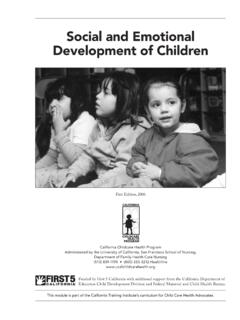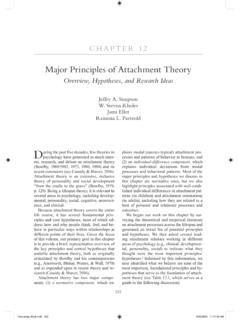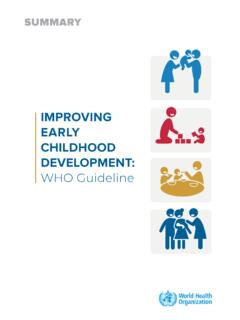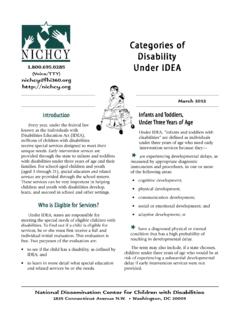Transcription of Child Development: A Brief Guide
1 0 6 months6 mth- 1year2 years3 years4 years5-11 years11- 21+ yearsPhysicaldevelopment(examples)Lifts front tobackGood onehand by feeds,drinks personwith , , full six years, knows left and right, ties a with rope, proficient with with precision and andlanguagedevelopment(examples)Attentiv e innew inresponse words by1 invocabulary/grammar lots of past, present, of mind-understandsthat other people havethoughts and feelings thatdiffer from one s can lie but sentences. 1,500 to memory solving feelings into of fluently and with of humour loves independent for abstract thinking, planning, looking previous knowledge/thinking about the hypothetical inorder to solve socialdevelopment(examples)A secure base isprovided througha relationshipwith caregiver(s)
2 Offering a safehaven and areliable base trust/ , inhuman rangeof attachment close play on own and discomfort/can manage Brief separationswith anxiety, but varies in at people range ofemotions including socialemotions pride, guilt,shame, responds to of gender, and othersocial roles and social roles/cultural in own past asks why ?Enjoys games with try new tasks, pride in achievements, accepts share and express wide range of to relate positively to peers, can work in a teamAble to hold secure base in mind when separated ( at school)so free to development - may follow or reject open to have extreme emotional shifts but managed with supportof of personal strengths and outside the home development /pro-social with be assertive/accept reasonable goals for the that secure base is available in times of difficulty isvery needs ofchildren in careor adoptedGenetic and pre-birth influences interact withthe caregiving weeks are crucial to development .
3 Thelonger the exposure to adverse caregiving, thelonger it will take to restore potentialdevelopment. But some infants can make agood recovery with reliable, sensitive may be preoccupiedwith unmet infantile may be withdrawn,chaotic, demanding,controlling. Caregiving thatfocuses on meeting previouslyunmet needs can repair often show poor self esteem and ability to relationships difficult and capacity to mange theexpectations of the classroom (concentration, working together,etc.) limited. But also children can discover fun/rewards fromrelationships & be a period of upward or downward spirals as some youngpeople come to terms with their history and develop strengths,while others are overwhelmed by anxiety about adult children and young people coming into care after adversity will need focused, sensitive caregiving that helps to fill the gaps in their earlier gaps are often formed in infancy and children at any age may appear preoccupied with unmet infantile needs such as feeding and comfort seeking.
4 They will also need special focus on building self esteem andcompetence and active support in developing interests and activities, managing relationships with peers and working together with adults. A comfortable sense of birth family membership and support and ongoingfoster/adoptive family membership can be highly restorative. Children and young people have an ongoing capacity to overcome adversity and benefit from security and emotional development : A Brief GuideThis chart was drawn from the following sources: Fahlberg, V (1994) A Child s journey through placement, London: BAAF;Sheridan, M (1997) From Birth to 5 years Children s Developmental Progress, London: Routledge; Schofield,G.
5 And Beek M.(2006) Attachment Handbook for Foster Care and Adoption, London: and supporting children s development is at the heart of social work with children and families. The Adoption Research Initiative longitudinal study of very young children at risk of significant harm , highlights the importance of childdevelopment knowledge for social workers. This chart is a Brief reminder of the typical stages of children s physical, cognitive and emotional development . It is by no means comprehensive and you are advised to refer to the referenced texts formore detailed information.
